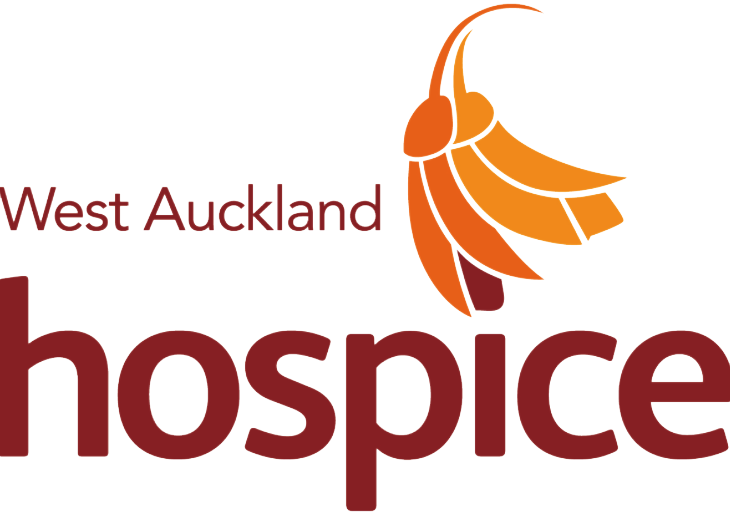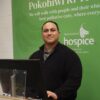Amy has been a Hospice Nurse at Hospice West Auckland for almost ten years, a role she says is her passion. “It’s more than just a job, it’s my purpose,” she smiles. “It is my passion in life to assure people have a good death.”
Amy is responsible for 20 – 25 patients at any one time, which she might see anywhere from once every six weeks up to four times per week depending on their needs. “Hospice nursing care focuses on addressing the whole person rather than just the physical symptoms. We are guided by patient/whānau on what they require. Our role is to recognize that patients have emotional, spiritual, psychological and social needs as well as physical needs,” says Amy.

8:00 am
Amy’s workday usually begins at 8:00am before their morning huddle at 8:15am. This is a meeting of the clinical and social care team members who are working that day, both out in the community and virtually. They discuss the calls which have come in during the night and changes in patients’ conditions – all of which could affect the team’s schedule for the day.
“Our clinical and social care team are amazing and work together so collaboratively,” Amy says. “I couldn’t do this work without the interdisciplinary team which work alongside me. We have such a dedicated team of health care professionals and supportive managers, which fosters a sense of whanaungatanga and a shared purpose. We’re so lucky that we all want the very best for these patients and families – everyone is so like-minded and dedicated.”
Every day is different, and the busy clinical team are continuously adapting to changing circumstances. “Your day can change from how it’s planned to be,” says Amy. “We are flexible in our workday in order to support patients’ changing needs.”

Following the morning huddle, Amy revises her scheduled visits to accommodate any appointments that may have come in overnight. Where possible she organises her visits around her patients’ residences to make travel time as efficient as possible. “Here in West Auckland the majority of our patients would like to be cared for and die at home, so we do everything we can to make that possible,” she says. “We usually spend an hour with each person, focusing on what matters most for them.”
“Before I enter a home, it is important for me to ensure that I am at my best, as I want to leave patients with a sense of peace, joy and ease,” Amy says. Hospice patients and their families are going through a difficult time, and her goal is to ensure they feel well supported and that she adds some ease to the situation.
10:00 am
Amy’s first stop is a joint visit with specialist Hospice doctor to see Janice*, who was diagnosed with pancreatic cancer. Janice stopped treatment months ago and recently Amy has been visiting weekly to help address her changing symptoms. Amy has requested a medical review as Janice phoned this morning because she doesn’t feel the medications are effective for her pain and nausea. After discussion today with Janice, her family, the specialist Hospice doctor and Amy, the plan is to change delivery of medications to subcutaneous, which is an alternative route for medications to manage symptoms. “I load up my car with supplies every week, including a syringe driver (or pain pump) so I am always prepared,” says Amy. The specialist Hospice doctor writes prescriptions and sends them to the pharmacy, arranging for the medication to be delivered that same day.
Amy also spends time providing emotional support to Janice and her loved ones, who are understandably concerned about her changing condition. “I make sure that they have a good understanding of what these changes might mean, prepare them for what is to come, and answer all of their questions,” says Amy. She plans to return that afternoon once Janice’s medications have been delivered to set-up the syringe driver and provide the family with training on how to use it.
11:30 am
Next Amy visits Graham*, a 69-year-old with colon cancer, and his wife, Margaret, who is caring for him at home. He has been feeling very weak and tired, with shortness of breath and dizziness. His recent test results show his haemoglobin is low and he requires a blood transfusion. However, Graham is very reluctant, telling Amy that the last time he went to hospital for a transfusion he had to wait for eight hours in the Emergency Department. Amy tells Graham she will phone the hospital team and see if this can be avoided. “We are our patient’s advocate, we do what we can to provide the best possible care for our patients,” she says.
While waiting to be phoned back, Amy assesses Graham and Margaret’s home to see if they could benefit from more practical support, such as in-home care or additional equipment to make mobility easier. She also suggests they might like to attend some of the group sessions at Hospice House, for example the Kowhai Social Group, which offers gentle activities and an invaluable social connection for patients and carers.
The hospital returns Amy’s call to say they will place Graham on the top of the list tomorrow and will do their best to provide the blood transfusion as efficiently as possible. This is very reassuring for Graham and Margaret to hear, and he quickly agrees to getting the procedure done. Amy sets a reminder to follow up with him in two days’ time.
1:00 pm
Amy’s next patient is Sarah*, a 42-year-old with a diagnosis of breast cancer with brain metastases. She has recently commenced palliative radiotherapy and is struggling with nausea. Sarah has been prescribed three anti-nausea medications and is unsure what to use. Amy suggests which medicine should best support the type of nausea Sarah is experiencing. “I’m hoping that if Sarah can get her nausea under control it will make a big difference to her energy levels and emotional wellbeing,” says Amy.
With her medication organised, Amy then spends time with Sarah and her husband, Donald*, discussing how else Hospice can be of a support. Sarah and Donald mention they are concerned about their 12-year-old daughter, who has become withdrawn and is falling behind in schoolwork. Amy suggests that she make a referral to Hospice Counsellor which they both agree would be helpful for all.
2:00 pm
Amy returns to the home of Janice to set up her syringe driver now that the medication has been delivered from the pharmacy. Amy educates Janice and her family about the rationale of subcutaneous (beneath the skin) administration, how to administer the medication, and how to manage a syringe driver. She also provides written information for them to refer to. She places two subcutaneous sites in Janice’s left arm as Janice informs her that she likes to sleep on her right side. Amy ensures that Janice has adequate supply of medication and equipment, then makes a plan to return the next day to ensure that symptoms are well managed and that Janice and her family are feeling supported.
2:45 pm
In the afternoon after completing her visits, Amy completes all documentation of the day’s work. “If it’s not documented, it’s not done as we learned in nursing school!” she smiles. “The HWA Afterhours Advisory team is reliant on the community nurses to document everything in the system in case patients or carers phone in overnight.” Follow-up actions include a plan to check in with Graham in two days’ time to see how he is feeling after his blood transfusion, contacting Sarah the following day regarding her nausea symptoms, putting in a referral for counselling for Sarah and Donald’s daughter, and Janice’s syringe driver follow-up visit.

3:30 pm
It’s time for the 3:30pm huddle for handover to the Afterhours Advisory team. “We share patient updates and discuss any concerns we have, so the Afterhours team are caught up with the day’s events and as prepared as possible for overnight,” says Amy.
Like the rest of the dedicated Hospice West Auckland team, Amy is grateful to have a role that is incredibly meaningful and rewarding. Amy says: ‘Throughout our day as Hospice nurses we demonstrate compassion, expertise and a holistic approach to care. We ensure that our patients and families experience comfort and dignity in their final days within the best of our abilities. I continue to do this work because, for me, it’s about the meaningful connections, having the opportunity to form deep, compassionate relationships with patients and their whānau, providing comfort during some of life’s most challenging moments.”
*All names and circumstances have been changed to protect privacy










